This past August and September, as you’re undoubtedly aware, wildfires burned throughout California and many other parts of the Western United States, killing 24 people, destroying more than 4,000 homes, businesses,
and other structures, and scorching more than three million acres—the size of Connecticut. On August 20, one of those fires threatened Bonny Doon, a small mountain town south of Santa Cruz that is home to about 3,000 people. As the flames grew nearer, 40-year-old NataliaJessen Flechsig, along with her father, mother, husband, and two friends, chose not to evacuate and instead stayed to fight the fires themselves. Here, in her own words, Natalia tells the story of how they not only saved their own homes, but many others in the rural community.
My farm, Deerhaven Herb & Flower Farm, has been in my family for almost 40 years. We have 8,000 lavender plants that we use to make soap, essential oil, and candles. At harvest time in October, people come and pick the lavender themselves, and we also sell floral water and salves.
Both of my parents grew up in Bonny Doon, and so they know the mountain, the forest, and the environment really well. I grew up here, too, and I came back with my husband and two kids, ages 6 and 8, to live here as an adult. My grandparents live here as well, so we have four generations on the mountain.

In addition to the lavender plants, our land has three homes, two workshops, two barns, one pool house, and a chicken coop. In 2008, my dad stayed on his own to defend our property against the Martin Fire [which burned 500 acres and destroyed 11 homes]. We lost our home, one workshop, the pool house, and the coop, but he managed to save the two other homes, the barns, and the other workshop. Through that experience, my dad really got an understanding of how fire works. He noticed that it blew through quickly, leaving most everything untouched, but then he saw embers fall from the sky in its wake that created new spot fires that ultimately claimed several buildings.
When fire season approached this year, we made a plan. Now that my husband and I have kids—ages 6 and 8—we had to pick who would stay, who would go, and what we would pack. We decided I would leave the farm with our kids, pets, and important items while the rest of my family stayed behind. We had spent much of the year clearing brush, making fire breaks, and keeping trees away from the house. We figured as a last resort, my family members could jump in our pool to protect themselves from the fire.
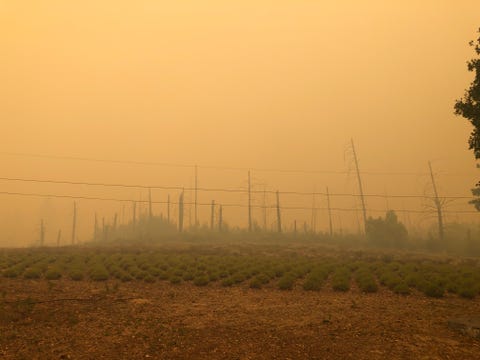
But even though we had the plan, it didn’t work out the way we had hoped. The fire came to Bonny Doon on a Tuesday night, and when the evacuation orders came in, I was already at our home in Santa Cruz—15 miles away—because it was less smoky there than up in Bonny Doon. My kids were there with me, but my cat was not, so I decided to head up the mountain. I called my parents about midnight and woke them up, telling them I was coming to help and pack up stuff. As I drove up the mountain, I passed multiple cars who were leaving. It was windy and the air was full of ash—I had no idea what I was driving into. But I wasn’t thinking about fear or the unknown; I was focused on getting my cat into its crate and helping my parents with whatever they needed last-minute. By the time I arrived at the farm, we could see a small orange glow in the distance and estimated the fire was 5 to 10 miles away.
The setup was all very strategic. We put a ladder up to every roof so we could quickly climb up and put out any spot fires if embers landed on top of them. We arranged an elaborate system of hoses, which were connected to three 3,000-gallon water tanks; we even had a generator to run the water pumps once we lost power. The plan was for my dad to keep the water tanks from melting, while my mom kept the ground damp around the three houses.
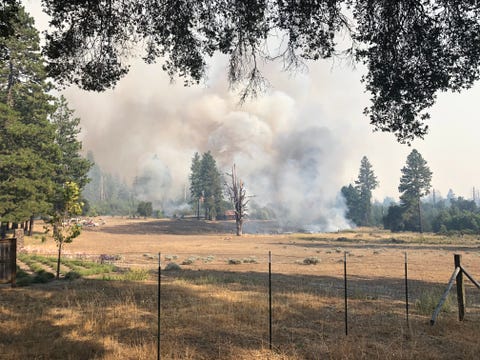
After we finished setting up, at about 6 a.m., I went back to Santa Cruz where my kids were staying with a friend. I knew the fire was going to come later that day and it was hard to say goodbye and leave my mom there with her little garden hose. My dad is 63, but he is so able bodied—he’s been a logger, a fisherman—so I knew if anyone was up to the challenge, it was him. And my mom had the car packed and ready, just in case.
The next afternoon we realized it was a bigger fire than we had anticipated. Cal-Fire did not show up—they had stopped clearing the fire roads years before so there was no way to drive trucks up, and the smoke was so bad that they couldn’t fly in air support. My family was on our own.
We knew we would need more diesel for the generators as well as ice and water, so a friend and I made supply runs. We were in communication with my parents so we had firsthand knowledge of how safe it was to go up a specific route. We made two trips on Thursday Aug. 20, and one trip on Friday, Aug. 21, leaving just as the fire reached our farm.
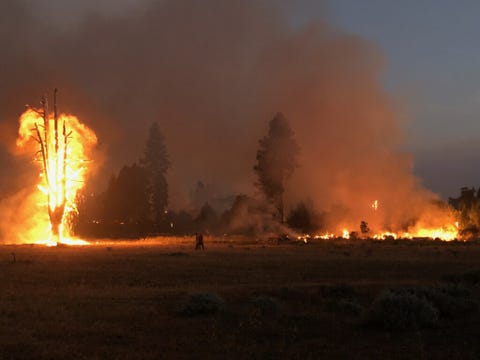
By day two of the fire, people started gathering at our farm. Even though we’re so close to Santa Cruz and Silicon Valley, we don’t have any cell service in Bonny Doon. But in our driveway, people can get one or two bars of service, so our property became a gathering place. On Wednesday evening, my parents and I decided to start collecting supplies and feeding the locals who stayed on the mountain. Family and friends reached out to donate to help so we had some immediate funds to use. I put the word out on our local Facebook page for those still in Bonny Doon to get food, water, 1-2 bars of cell service, and any other help at our farm. Soon, my mom also started cooking three meals a day for 30 people each day. People came to the farm to check on each other, and also for supplies like ice, diesel, gas, and pet food.
Once our property was secure, my mom and her friends started going around with homemade water trucks—pickup trucks with water tanks in the back along with a small generator to power the hose—to put out spot fires around the area. They saved many homes on the mountain.

At times, the fire had 40-foot tall flames; at one point, it came within 10 feet of my parents’ house, but didn’t get closer because my mom had kept the area around the house damp. Flames touched one corner of our lavender fields too, but didn’t get far, because we had cut down all the trees and brush around the field, so it didn’t have fuel and went out. Fire burned all around us but didn’t get to us. Our farm is now surrounded by brown trees; half of our meadow behind the farm is black.
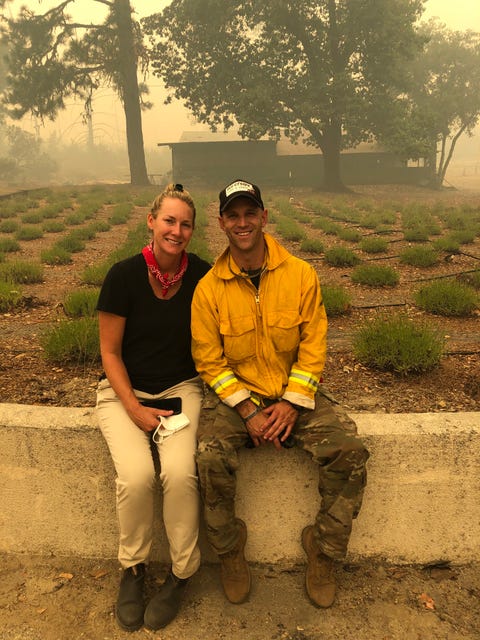
But it’s hard to celebrate when many of our friends lost their homes. This is a very close knit community, not just during the fires. We have a lively Facebook page, a big local garage sale, a plant exchange. You know your neighbors and when someone needs help, you help them. We have a lot of dinners and parties up on the mountain—you don’t see that as much in neighborhoods anymore—so people don’t think twice about trying to help save one another’s homes. In all, fire officials estimate 200 to 300 homes were lost in our little town alone, and about 1,000 structures.
I know my family took a risk in staying behind, and I know this might sound crazy, but it never felt unsafe. I even asked my mom if she wanted to leave with me a few times and she said, "I know I am safe here, I can always jump in the pool if it gets really crazy, which I know it won't. I have to take care of Dad and feed all these people up here." It was hot and smoky, fire surrounded the farm, but we always felt like we were in control.
I’m proud of the work we did to fight the fires and save our homes, but it’s also frustrating that we didn’t have any help. Cal Fire’s focus was on the northern edge of the fire as it spread toward nearby Santa Cruz and more populated areas. Their resources were spread so thin, so I think they made the decision to sacrifice our community so they could fight the front of the fire. People were upset about that, and felt it was unfair to put resources in one area at the expense of another. If locals hadn’t stayed, I guarantee the rest of the mountain would have burned.
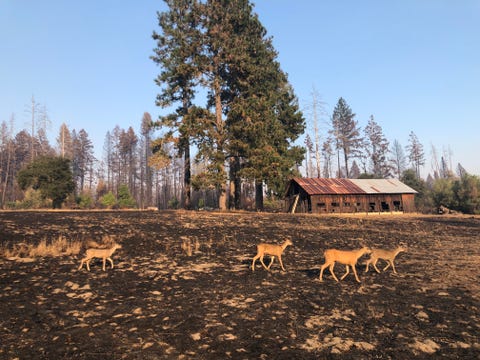
Looking forward, I know fire prevention management is going to be a big topic in our community. Since there is no cell phone service and people now recognize how important that is in an emergency, there’s also going to be a big push for cell phone towers. We’re now fundraising to rebuild what was lost, looking at how we can take care of the community and children here. Our community acted quickly when there were no other emergency services to help us, and I am so proud of how people stepped up. Whether it was buying supplies, donating, or staying to fight—everyone helped each other, and I'm in awe of what we accomplished in just five days.
